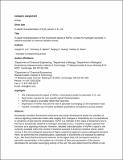In-depth characterization of the fluorescent signal of HyPer, a probe for hydrogen peroxide, in bacteria exposed to external oxidative stress
Author(s)
Lim, Joseph B.; Barker, Kimberly A.; Huang, Beijing Kara; Sikes Johnson, Hadley
DownloadLim and Sikes 2014 JMM.pdf (1.127Mb)
PUBLISHER_CC
Publisher with Creative Commons License
Creative Commons Attribution
Terms of use
Metadata
Show full item recordAbstract
Genetically encoded, fluorescent biosensors have been developed to probe the activities of various signaling molecules inside cells ranging from changes in intracellular ion concentrations to dynamics of lipid second messengers. HyPer is a member of this class of biosensors and is the first to dynamically respond to hydrogen peroxide (H[subscript 2]O[subscript 2]), a reactive oxygen species that functions as a signaling molecule. However, detailed characterization of HyPer's signal is not currently available within the context of bacteria exposed to external oxidative stress, which occurs in the immunological response of higher organisms against invasive pathogenic bacteria. Here, we performed this characterization, specifically in Escherichia coli exposed to external H[subscript 2]O[subscript 2]. We found that the temporal behavior of the signal does not correspond exactly to peroxide concentration in the system as a function of time and expression of the sensor decreases the peroxide scavenging activity of the cell. We also determined the effects of cell number, both before and after normalization of externally added H[subscript 2]O[subscript 2] to the number of cells. Finally, we report quantitative characteristics of HyPer's signal in this context, including the dynamic range of the signal, the signal-to-noise ratio, and the half saturation constant. These parameters show statistically meaningful differences in signal between two commonly used strains of E. coli, demonstrating how signal can vary with strain. Taken together, our results establish a systematic, quantitative framework for researchers seeking to better understand the role of H[subscript 2]O[subscript 2] in the immunological response against bacteria, and for understanding potential differences in the details of HyPer's quantitative performance across studies.
Date issued
2014-08Department
Massachusetts Institute of Technology. Department of Biological Engineering; Massachusetts Institute of Technology. Department of Biology; Massachusetts Institute of Technology. Department of Chemical EngineeringJournal
Journal of Microbiological Methods
Publisher
Elsevier
Citation
Lim, Joseph B., Kimberly A. Barker, Beijing K. Huang, Hadley D. Sikes. "In-Depth Characterization of the Fluorescent Signal of Hyper, a Probe for Hydrogen Peroxide, in Bacteria Exposed to External Oxidative Stress." Journal of Microbiological Methods 106 (November 2016), pp.33-39.
Version: Author's final manuscript
ISSN
01677012